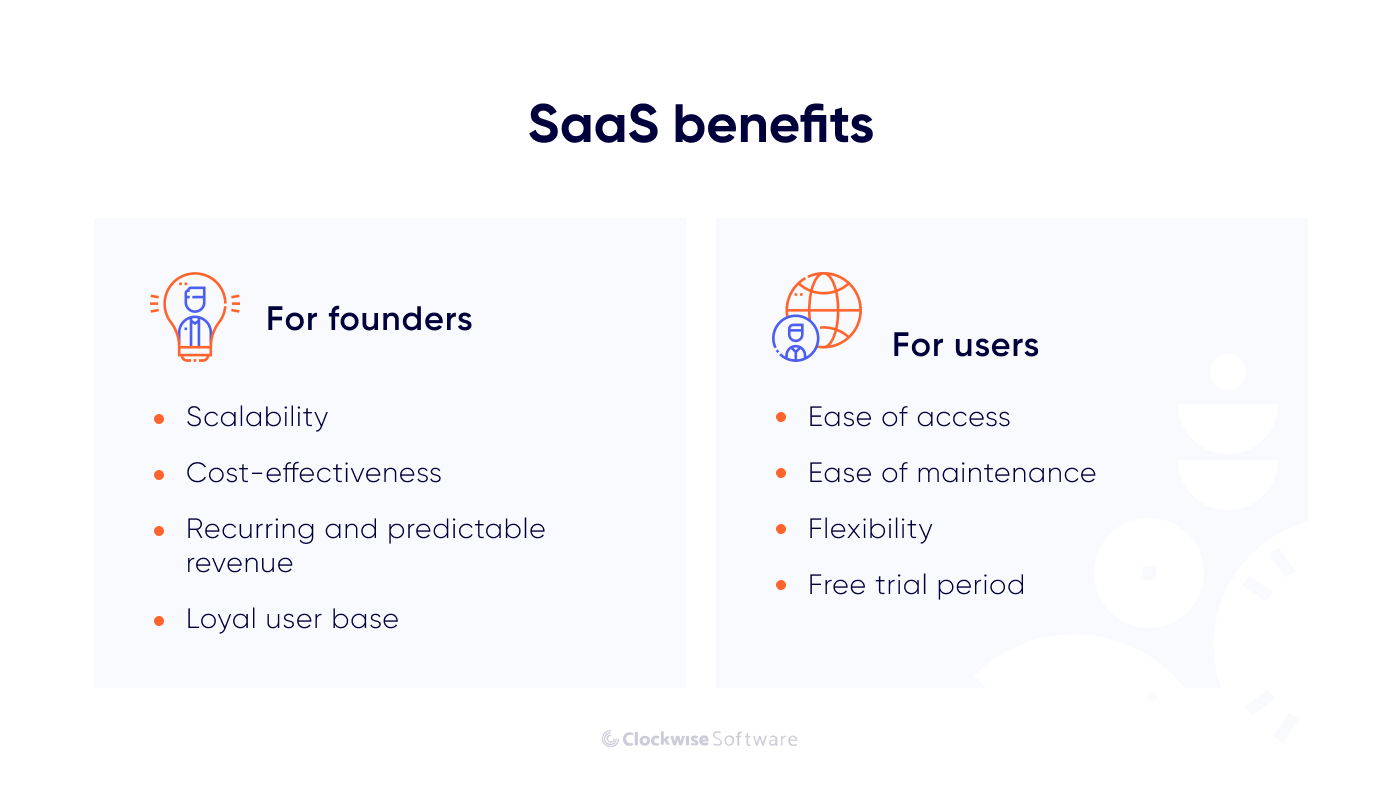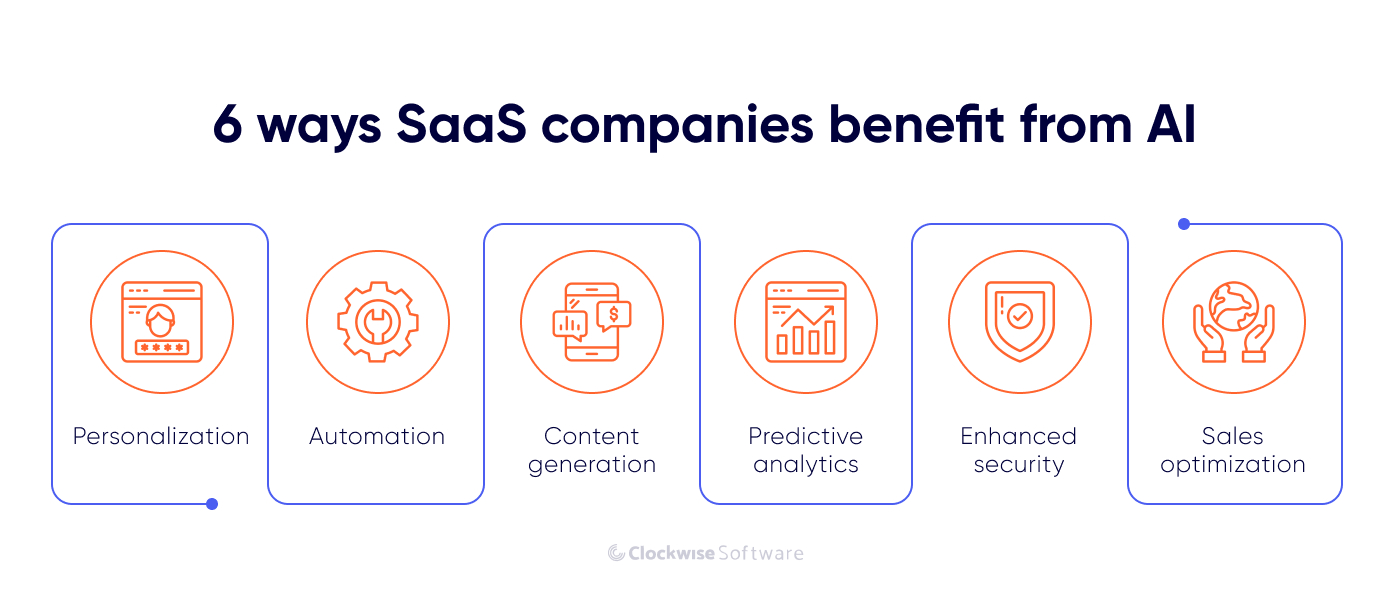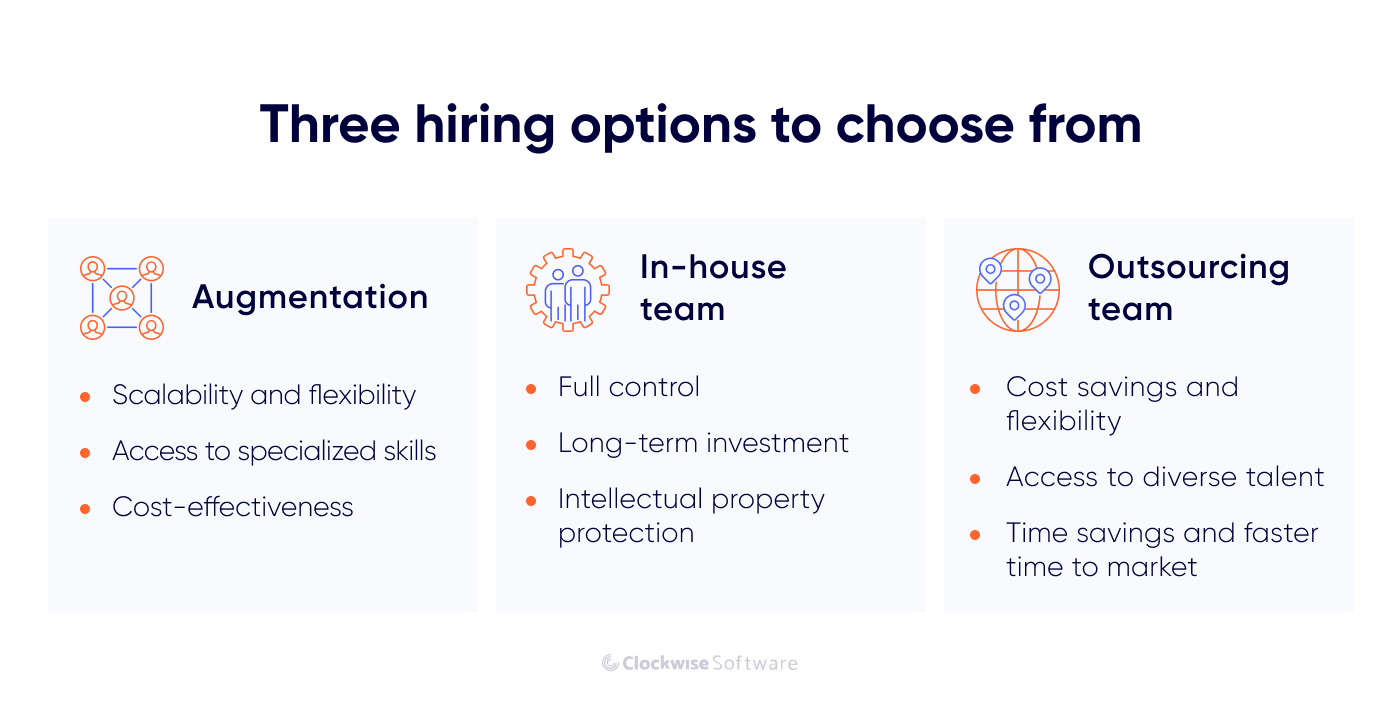What we do
Services
Experts in
If you are a founder wanting to create your own AI-powered SaaS product, now is the perfect time to enter this growing market. However, building a scalable and competitive AI SaaS platform requires more than just a great idea — it involves choosing the right technology and structuring a development process that minimizes risks and maximizes value.
At Clockwise Software, we specialize in SaaS product development services, helping businesses design, build, and launch AI-driven SaaS solutions that stand out in the market. Over the last few years, we have developed over 25 SaaS applications, with six more currently in different stages of active development. With our experience in integrating AI into software products, we ensure that your platform is not only functional but also optimized for performance, security, and scalability.
This guide is for you if you’re AI software development from scratch or want to integrate AI into your existing platform.
Let’s dive into the process of developing an AI-powered SaaS product.
Before we dive into the development process, it’s necessary to explain what a SaaS product is.
Software as a Service (SaaS) is cloud-hosted software that is owned and managed remotely by one or more providers and is delivered to users on a subscription basis. The SaaS business model offers a lot of benefits to both founders and users. Let’s take a closer look.
This is how you can benefit from building a SaaS AI platform:
For users, these are the key benefits of a SaaS app:

As you can see, there are a lot of benefits the SaaS model can offer for both founders and users. No wonder the global size of the SaaS market, which was valued at $151.31 billion in 2022, is projected to reach $896.2 billion by 2030.
If you have already researched the topic, you’ve probably noticed that SaaS is quite similar to cloud computing. Indeed, the difference between cloud vs SaaS is subtle. Nevertheless, it exists. In simple words, cloud computing is a broader term that refers to delivering resources (files, pictures, videos, etc.) over the internet, while SaaS is a specific cloud computing service model that provides certain services via the internet on a subscription basis.
Since its introduction in the early 2000s, SaaS has eliminated cost, efficiency, and compatibility challenges for businesses. Implementation costs have been reduced as the SaaS model allows easy access to software without requiring installation, saving both time and money. Additionally, businesses no longer need extensive (and expensive) data storage and warehouses.
However, one question remains: Will AI give a boost to SaaS or destroy it, leaving it in the past?
Generative AI will be for SaaS what Mobile was for Web 1.0. SaaS companies will either be disrupted or turbocharged by it.
This is what David Sacks, co-founder and partner of Craft Ventures, thinks about the future of AI for SaaS companies. With AI, high-growth SaaS companies can understand their customers better, predict their needs, and offer targeted solutions. Besides, you can use the SaaS platform for backing up data.
Unfortunately, we can’t predict the future (even with the help of the most innovative AI-based predictive analytics tool). What we can say for sure is that AI is being successfully used in a broad spectrum of SaaS products.
In 2016, Salesforce launched Einstein, a powerful AI tool. By analyzing customer behavior through machine learning, Einstein helped enhance client relationships. Fusing unstructured data from Einstein and IBM’s Watson enabled businesses to gain valuable insights, assisting in resolving customer service issues and targeting seasonal customers based on purchase patterns and external factors.
Four years later, in 2020, Box, a cloud-based content management platform, introduced Box Skills — an AI-powered feature that uses computer vision and natural language processing to automatically classify and tag content uploaded by users. This feature enables users to extract valuable insights from unstructured data, improving content organization and search. Additionally, the integration of AI-driven transcription and translation services within Box Skills made it easier for businesses to manage multilingual content.
Today, AI as a Service goes beyond data analysis. With natural language processing and deep learning, AI assists in areas previously requiring humans. It includes advanced services for natural language processing and computer vision, recommendation systems, predictive analytics, generative AI, speech-to-text and text-to-speech, and AI-enhanced automation.
With AI projected to reach a market value of $733 billion by 2027, its integration will continue to change SaaS industry trends.
As you can see, AI is only increasing in relevance. Hence, AI integration into SaaS is inevitable, especially since it has many advantages. Many businesses now rely on professional AI integration services to ensure their SaaS products effectively leverage AI capabilities, from predictive analytics to automation and personalization.
Some people call this artificial intelligence, but the reality is this technology will enhance us. So instead of artificial intelligence, I think we’ll augment our intelligence.
This saying reflects a perspective on how to perceive and embrace AI advancements. Ginni Rometty believes that rather than thinking of AI as a replacement for human intelligence, it should be seen as a tool to enhance and extend human capabilities. Let’s see how this revolutionary shift can improve your product:
In any business, personalized products and services are valued by customers more than those that are one-size-fits-all. They analyze customer interactions and help businesses understand and cater to customers’ needs and preferences.
Since every customer is unique, how can you personalize your offerings? One effective approach is allowing customers to choose the product features that best fit their needs. With the help of AI, you can gather information about customers to gain deeper insights into their preferences. You can then segment customers into distinct groups and create unique product versions tailored to these groups’ requirements.
Given the undisputable value of each customer, the inclusion of predictive analytics within SaaS solutions offers substantial benefits.
AI-driven automation can reduce the number of repetitive, routine tasks, reducing manual intervention and, in this way, improving efficiency. Such features as AI-powered chatbots and virtual assistants can handle customer support 24/7, providing instant responses to queries, onboarding customers, and more.
Nowadays, nobody asks what GPT-3 is anymore. Text generators like GPT-3 and GPT-4 have gained significant popularity as AI tools. Marketers use them to generate large volumes of material including content plans, articles, and social network posts.
Companies use AI tools and implement GPT-3 integration for the following purposes:
Of course, today’s AI-generated content is far from perfect. Still, the integration of content generators has the potential to enhance human work and streamline the writing process.
Using machine learning algorithms, businesses can analyze past data to identify trends and predict future events. This helps them understand customer behavior, forecast product demand, and find growth opportunities. Additionally, AI can optimize business processes by identifying potential issues in areas like supply chain management and customer service before they occur.
AI offers SaaS companies enhanced security through various means. AI algorithms can detect and prevent security threats, monitor network activity in real time, identify anomalies, improve user authentication with biometrics, detect fraud, ensure data privacy and compliance, and utilize predictive analytics to prevent breaches. By leveraging AI-powered security solutions, SaaS companies can enhance their security measures, protect sensitive data, and create a secure environment for their customers.
AI can determine the methods that generate the highest sales. AI and ML can assist in analyzing sales data, identifying patterns, and recommending strategies to optimize the sales process and increase conversion rates.

As you can see, AI offers numerous advantages for SaaS companies. In this part, we explain how to create an AI-powered SaaS product.
Careful validation and planning is a must for any project. Let’s look in detail at what you need to do before proceeding to actual development.
If you’re looking for ways to create an AI SaaS product, you probably have some idea in mind. However, how can you be sure that it’s possible to bring your idea to life?
One way to eliminate the risks associated with your future product is using a Proof of Concept (PoC). The PoC is a sort of small-scale experiment aimed at validating a particular idea’s feasibility. This is especially important when it comes to products with AI implementation, since such software projects are more complex and less predictable than usual.
There are three types of PoC: a proof of technology (focuses on testing the feasibility and functionality of a particular technology or technical component), steel thread (encompasses all technologies that will be used in software project development), and pilot project (a small-scale implementation of certain features for testing). If you want to know more about PoC and how to create one for your project, read our article that explains what PoC is in detail.
The primary goal of any software project is to satisfy the users’ needs. That’s why analyzing the target audience is a crucial step to take before development.
First, you need to identify the customer segment you’re targeting and identify their needs and preferences. Second, you need to conduct market research to gather the necessary data about users’ pain points and software expectations (this data can be gathered with the help of surveys or interviews with potential customers). The gathered information will help you create a user persona — a representation of your ideal customer. Based on this, you will get a better understanding of what your product should be and what features to offer.
After a thorough analysis of your target audience, you can choose features to implement in your product.
When developing a new product, it’s especially important to eliminate all possible risks and allocate resources wisely. That’s why we recommend developing a minimum viable product (MVP) — the first version of a product that contains a minimal set of features: enough to be assessed by users. This approach offers numerous advantages, allowing you to:
As you can see, launching a startup with an MVP is a risk-proof decision that has a lot of benefits in comparison to launching a full product, which implies large upfront investment without any guarantee of success.
For an MVP, you need to choose one or a few core features (based on the results of target audience analysis). For example, for an AI-based MarTech SaaS solution, you may want to consider such AI features as predictive analytics, chatbots and virtual assistants, automated reporting and dashboards, and voice search optimization.
A software requirements specification (SRS) is a comprehensive and structured description of a software system’s requirements. Throughout the development process, it serves as a guide for the development team and stakeholders.
An SRS document contains information about the project’s purpose, scope, functional and non-functional requirements, and more. It may be laid down according to a specific standard (IEEE/ISO/IEC 29148), or it can be created in another form that is convenient for the team.
Once you have identified your SaaS product’s critical features, the next step is to consider how you will bring them to life. There are several options. You can augment your existing team with AI specialists, or you can hire an in-house or outsourcing team. Let’s discuss all of these options and what they can offer.
If you already have an existing product and a working team, consider augmenting it with external AI expertise. This can be done by either hiring AI developers as full-time employees or outsourcing this aspect of work to a company with corresponding expertise that offers Dedicated development team services.
If you hire all the necessary specialists in-house, you will get a dedicated development team that works solely on your project on a full-time basis. Building an in-house team ensures a more streamlined development process and maintains better control over the project’s direction and timeline.
When building an AI SaaS app from scratch, the team should include a business analyst (BA), UI/UX designers, AI/ML developers, backend and frontend developers, and QA engineers. It’s crucial to have team members who possess strong technical skills, particularly in data science, as well as industry knowledge and experience.
A web development outsourcing team will be well-versed in the challenges and best practices associated with AI SaaS product development. On average, hiring a skilled software engineer in the United States or Canada takes 50+ days and requires dedicated recruitment efforts, lengthy interviews, and extensive process analysis. These 50+ days could instead be utilized to launch a small yet valuable MVP. You can find and hire an outsourcing team in one work week, and, this way, reduce the web app development cost.
Another advantage you will get if you decide to outsource web development to a third-party company is that you will be able to focus on your business tasks, while your outsourcing team will handle everything starting from idea validation and SRS creation (within the scope of a discovery phase) and right to the product’s development and launch.

Some AI features are entirely new for users, as they may not yet exist among competitors or in applications from other industries. That’s why your software’s interface should be concise and intuitive.
When optimizing your SaaS product’s user interface (UI), it’s crucial to adhere to the following practices:
As usual, the final part of the design stage is creating a prototype that is developed by a UI/UX designer and approved by all stakeholders.
For AI SaaS product development, you need to choose technologies for:
The back end is the server side of the software that is invisible to users. There are a few backend technologies that work great for AI software development:
Apart from programming languages, you may also consider Amazon machine learning and Microsoft CNTK.
Amazon machine learning is a trusted framework in the AI community that offers a range of benefits for the development of self-learning tools, data analysis, and model training. This framework is used by developers of all levels and provides a high level of security thanks to data encryption.
Microsoft SNTK is a deep learning framework focused on training and deploying deep neural networks. It supports various programming languages, making it accessible for a broad range of developers.
For frontend development, you will have to use HTML (HyperText Markup Language, which provides the structure of the page), CSS (Cascading Style Sheets, which deal with the layout and the elements on the page), and JavaScript frameworks (that are responsible for interactivity). You can choose from such JavaScript libraries as React.js, Vue.js, and Angular.
Apart from technologies for the front end and back end, development of a SaaS product involves choosing a cloud provider to host your app, selecting APIs for integrations, and other aspects. All of these choices should be in consultation with technical experts within your team.
If you don’t have the necessary expertise in AI SaaS development in-house, you can work with a software development company that offers Chief Technology Officer (CTO) as a Service — a tech expert that provides on-demand support for all tech-related questions such as those related to team composition and development and testing strategies.
The development process is carried out along with the testing process. Software developers work in collaboration with QA engineers to ensure that the software works correctly before it gets into end users’ hands.
After the first version of your product is launched, your main task is to listen to your customers, collect and analyze feedback, and provide regular fixes and improvements to your AI SaaS product. You also need to constantly monitor current trends in web development to stay ahead of your competitors.
Artificial intelligence would be the ultimate version of Google. The ultimate search engine that would understand everything on the web. It would understand exactly what you wanted and give you the right thing. We’re nowhere near doing that now. However, we can get incrementally closer to that, and that is basically what we work on.
You have just read a guide to building an AI SaaS application. Yet, you may doubt whether it’s worth getting involved in this field of software development. We believe that it is, and we will provide several proofs that AI is here to stay and that demand will only grow.
The statistics above demonstrate that the importance of AI for businesses will grow significantly in the coming years. With such opportunities as CTO as a Service, software development consulting services, and outsourcing, you can launch your own AI SaaS product with relatively little effort and even if you have a small amount to invest.
We’ve just covered a lot of information, so let’s take a second to recap. The SaaS industry is growing rapidly, driven in part by integration of AI that enhances the user experience in SaaS products by offering personalized recommendations, increased automation, predictive analytics, and other benefits.
Developing an AI-based SaaS product requires careful planning and a competent technical team. It’s also crucial to prioritize customer needs and choose an appropriate technology stack.
